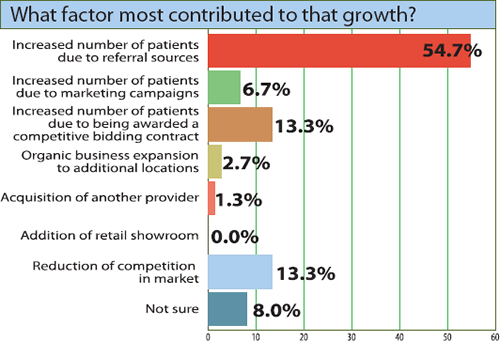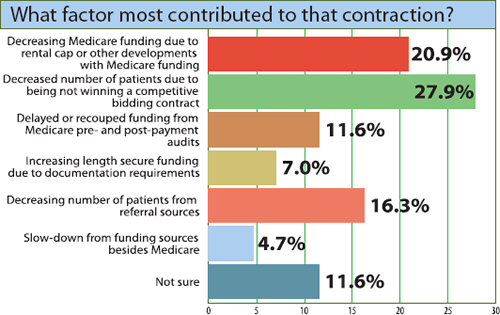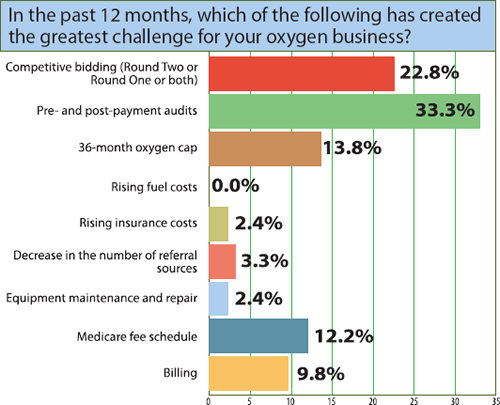2015 Oxygen Market Survey
Oxygen Enjoys a Spike in Business Growth
Providers report a 12% increase in those enjoying business growth over the last 12 months.
- By Joseph Duffy
- Oct 01, 2015
There has been much discussion about how the expanding patient base could give the respiratory industry the boost it needs. Industry experts have pointed out that an exploding senior population, the efforts to cut hospital admissions and the desire of the elderly to live out their days in the comfort of their own homes paint a picture of hope in respiratory providers finding enough market share to keep growing their business.
According to HME Business Magazine’s Eighth Annual Oxygen Market Survey, about 65 percent of respondents said that their oxygen business grew in the past 12 months. This is a significant jump from last year, where 53.1 percent of respondents reported growth. More about this year’s growth:

- 29 percent of respondents said they grew between 6 percent and 10 percent
- 26.8 percent grew between 11 percent and 15 percent
- 14.6 percent grew less than 5 percent
When it comes to the factors that most contributed to respiratory provider growth, three of the top four factors involved an increase in the number of patients:
- 54.7 percent of respondents said they had an increased number of patients due to referral sources (54.5 percent in 2014)
- 13.3 percent had an increased number of patients due to being awarded a competitive bidding contract (9.1 percent in 2014)
- 6.7 percent has an increased number of patients due to marketing campaigns (10.2 percent in 2014)
Last year, 14.8 percent of respondents said their growth was due to the reduction of competition in the marketplace. This year, that number was 13.3 percent.

Contraction numbers were fairly similar when compared to last year’s survey. Fifty percent of respondents this year reported that less than 5 percent of their business contracted, where 41.8 percent reported less than 5 percent contraction last year.
Respondents said the factors that most contributed to contraction included:

- Decreased number of patients due to not winning a competitive bidding contract (27.9 percent)
- Decreasing Medicare funding due to rental cap or other developments with Medicare funding (20.9 percent)
- Decreasing number of patients from referral sources (16.3 percent)
Who are Your Patients?
According to “Continuing to Confront COPD International Patient Survey,” COPD has risen from the fourth leading cause of death to the third, after heart disease and cancer, and has gained in prevalence over the past decade, growing from 6 percent to 7 percent of adults ages 40 years and older.

For 94 percent of survey respondents, COPD is the primary diagnosis for their oxygen patients. The percentage of their respiratory client base that has COPD was:
- 49.9 percent of respondents said 51 percent to 75 percent of their patients have COPD
- 23 percent of respondents said 25 percent to 50 percent of their patients have COPD
- 19.4 percent of respondents said more than 75 percent of their patients have COPD
For patients without COPD but use oxygen, respondents said that 55.2 percent of these patients have congestive heart failure, 13.4 percent have sleep apnea and 8.2 percent have pulmonary hypertension.
According to respondents, they say their COPD patients want the following:
- 81.9 percent of respondents said patients want access to portable technology
- 9.5 percent said patients want more comfortable therapy
- 4.3 percent said patients want access to pulmonary rehab programs and/or strategies of living with COPD
Respondents said their COPD patients overwhelmingly want portable oxygen concentrators (72.6 percent), followed by portable oxygen cylinders with conserving device (14.5 percent), liquid oxygen (5.1 percent), stationary concentrators (5.1 percent) and transfilling systems (2.6 percent). Of their oxygen devices, 60.2 percent of respondents said patients find portability most and 57.3 percent said weight is most important.
When it came to ease of use, 51.3 percent of respondents said their patients prefer stationary concentrators to portable oxygen concentrators (26.5 percent).
Challenges
In the last 12 month, respondents said pre- and post-payment audits (33.3 percent) created the greatest challenge for their oxygen business, while 22.3 percent said it was competitive bidding (Round Two or Round One or both). Pre- and post-payment audits had the same percentage as last year and competitive bidding dropped 6.8 percent from last year.

Regarding oxygen business challenges caused by Medicare funding cuts, respondents said they are:
- Maintaining customer service (34.8 percent)
- Delivering equipment/oxygen cylinders (25.4 percent)
- Maintaining respiratory therapist services (14.4 percent)
- Servicing and repairing equipment (10.2 percent)
- Providing oxygen for traveling/relocating patients (9.3 percent)
- Negotiating pricing for oxygen for traveling/relocating patients (5.9 percent)
Audits
Audits are a serious roadblock for HME providers. AAHomecare said the out-of-control Medicare audit system puts paperwork before patients, jeopardizes critical care for patients due to the overwhelming number of rubber stamp denials, and hangs small businesses out to dry in the ALJ claim backlog.
The majority of respondents (33.3 percent) said audits were their greatest challenge in the last 12 year. According to survey takers, 47.6 percent of respondents claimed that over last year up to 20 percent of their claims have been impacted by pre- or post-payment audits.
- 28.57 percent of respondents said 21 percent to 40 percent of their claims were impacted
- 14.3 percent of respondents said 41 percent to 60 percent of their claims were impacted
- 4.8 percent of respondents said 61 percent to 80 percent of their claims were impacted
- No respondents said 81 percent to 100 percent of their claims were impacted
For appeals occurring in the last 12 months, 33.3 percent of respondents said that between 61 percent and 80 percent of their audited claims have been successfully overturned by appealing.
- 28.57 percent of respondents were successful in appealing up to 20 percent of their audited claims
- 9.5 percent of respondents were successful in appealing from 21 percent to 40 percent of their audited claims
- 14.3 percent of respondents were successful in appealing from 41 percent to 60 percent of their audited claims
- No respondents were successful in appealing from 81 percent to 100 percent of their audited claims
Regarding the threat to oxygen businesses posed by OMHA’s decision to delay assigning ALJs to audit appeals by two years:
• 38.1 percent of respondents describe the threat as Moderate — The delay could represent a large chunk of my revenue being caught in limbo.
• 33.3 percent of respondents describe the threat as considerable — The threat posed by recoupment, fines and penalties is a major blow to my business.
• 19.1 percent of respondents describe the threat as some — It is a frustrating delay, but we’ll be able to suffer through it.
9.52 percent of respondents describe the threat as a game changer — Looking at the percentage of my claims audited and the dollar value of the recoupment, plus fines, plus delays is leading me to shutter or sell my business.
Competitive Bidding
Although 22.3 percent of respondents called competitive bidding the industry’s greatest challenge this year, a drop from last year’s 29.1 percent, competitive bidding remains a serious concern for respondents, especially those involved in the Round Two re-compete. About 71.4 percent of respondents who are in Round Two said they bid on the current Round Two re-compete.

A large majority of respondents (85.7 percent) said they expected further reimbursement cuts for oxygen with the Round Two re-compete.
And as CMS readies to expand competitive bidding reimbursement rates nationally on January 1, 2016, respondents were asked how they gauge the impact of this initiative on rural providers and patients. Respondents (85.7 percent) overwhelmingly said it will seriously impact on their patients’ care, while 14.3 percent said it will have limited impact on their patients’ care.
Who are the respondents?
According to our respondents, 43.8 percent of them are respiratory HME business owners, 35.9 percent are respiratory service managers, 19.1 percent are respiratory therapists at a homecare company and 1.2 percent are respiratory therapists at a hospital. Last year, a slight majority of respondents (39.2 percent) said their primary job was respiratory service manager while respiratory HME business owners were at 38.7 percent.
The majority of respondents (59.7 percent) don’t plan on leaving the oxygen business in 2016 because of competitive bidding, audits, the rental cap or other Medicare cuts. About 14.5 percent said they would be leaving next year while 22.6 percent are unsure.
The majority of respondents (32.8 percent) described their oxygen business model as a mixture of equipment options with emphasis on transfilling systems and/or POCs, while 31.3 percent said it’s a mixture of equipment options with emphasis on oxygen cylinder delivery.
- 25.9 percent of respondents said their model is stationary concentrators and oxygen delivery only
- 5.3 percent of respondents said their model is transfilling systems and POCs only
- .8 percent of respondents said their model is liquid oxygen only
Respondents who said they currently have a program to service traveling oxygen patients went from 71.1 percent last year to 78.5 percent this year.
This article originally appeared in the Respiratory Management October 2015 issue of HME Business.